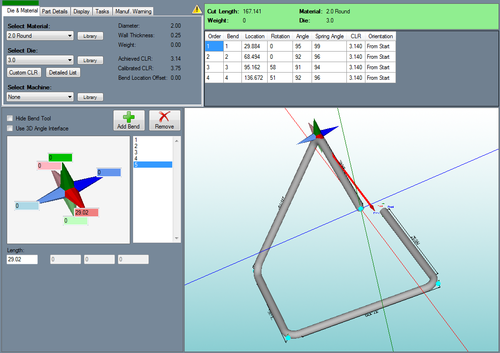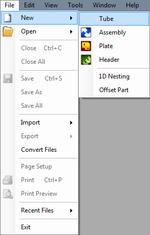Custom 3D Part
Bend-Tech 7x Wiki :: Custom 3D Part
Custom 3-dimensional parts can be created by entering ceiling/floor, left/right, and back/front coordinates or by using the 3D angle interface.
Selection
To create a Custom 3D Part:1.) Go to the File menu, select New, then select Tube. In the Create New menu, click on the Custom 3D Part option.
2.) Click the New Part icon and select the Custom 3D Part option in theCreate New menu.
...OR
3.) Select the Custom 3D Part option from the task menu that appears when the software starts up or when all designs are closed.
Design
Once 'Custom 3D Part' is selected, a new custom 3D part design window will open. If a default die and material have not been set, a die and material must be chosen before designing the part. If necessary, choose a material and die in the Die and Material tab. Once a die and material are selected, the custom 3D part design section will appear.
The number of bends can be chosen from the 'Number of Bends:' drop down menu by clicking it and selecting a bend amount. Up to 50 bends can be added to a part. To the right of the design coordinates, a list of every bend will be shown along with the end length.
Check the box next to 'Refresh on Keystroke' to have the 3D part display and results table updated immediately when changes are made in the part design section. Check the box next to 'Verification Points' to have blue points displayed on the part's starting point, the center of each bend, and on the end point in the 3D part display. Check the box next to 'Display Dimensions' to display the part dimensions on the part in the 3D part display.
To manually refresh the part display and results table, click the 'Refresh Part' button. This will only need to be done if 'Refresh on Keystroke' is not checked. To add a custom die centerline radius, click the 'Add Custom CLR' button. Enter a value and click 'OK'. Doing this will add the entered value to the die drop down menus as 'Custom - (Entered Value)'. This will basically act as a die with only the CLR value.
To enter coordinates for each bend, select the bend from the bend list and enter values into the ceiling/floor, front/back, and/or left/right coordinate fields.
Check the box next to 'Use 3D Angle Interface' to use the 3D coordinate interface with the currently selected bend.
The blue, red, and green circles each represent a plane or dimension- the green section is the right/left plane, the red section runs from the ceiling to the floor, and the blue section is the front/back plane. Each of these planes has four white points separated by 90 degrees around the edge. To enter coordinates while in the 3D Angle Interface, select the bend and select one of the white points on a plane to choose a direction. Once a direction is chosen, enter any necessary values into the Angle and Length, Ceiling, Floor, Back, Front, Left, or Right fields that appear below the compass. Only one of these three fields to the right of the 'Angle' field can have a value at a time. For example, if a value is entered into 'Length' field while the 'Back' field has a value, the 'Back' field will be set to a zero.
To rotate the compass, click and hold the right mouse button and move the cursor to rotate.
Each bend can be assigned to a die by either selecting the bend number in the bend list and selecting a die or custom CLR from the drop down menu next to 'Die:' or clicking the 'Detailed Die List', clicking on the desired die, and clicking the 'Select' button. Each bend can also be assigned to a dimension type by selecting a bend from the bend list and selecting either Apex or Tangent from the drop down menu next to 'Dim Type:'. Apex will measure to the outside intersection (apex) of the bends two legs. Tangent will measure to the edge of the bends, the tangents, so no bent material will be included in the measurements.

